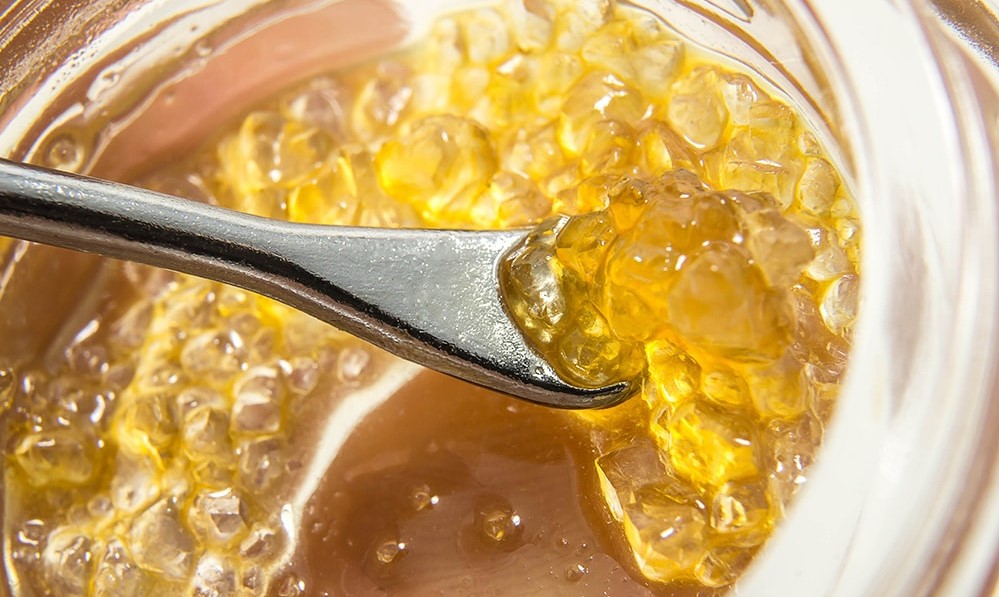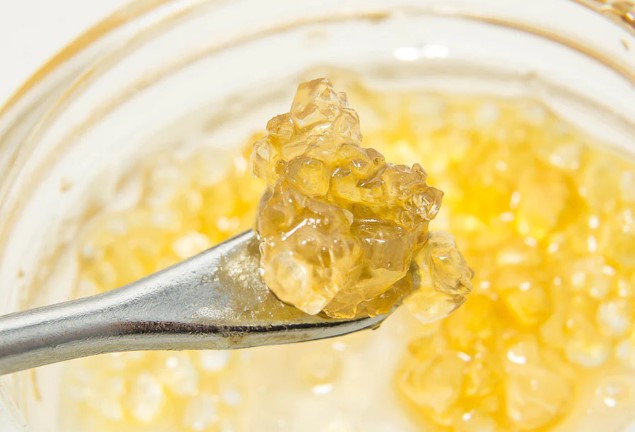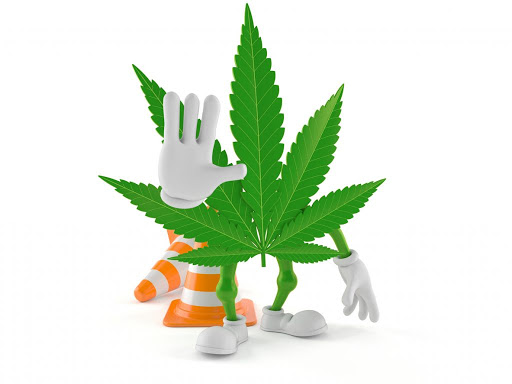THC crystals and THCA crystalline are powerful forms of cannabis concentrates that have gained popularity for their high potency and versatile applications. In this comprehensive guide, we’ll explore the origins, production methods, uses, benefits, drawbacks, and proper consumption of these crystalline forms.
Table of Contents
What Are THC Crystals?
How Are THC Crystals Made?
Potential Benefits and Uses of THC Crystals
Potential Risks and Side Effects of THC Crystals
What is THCA Crystalline?
How is THCA Crystalline Made?
Benefits of THCA Crystalline
Drawbacks of THCA Crystalline
How to Use THCA Crystalline
What Are THC Crystals?
THC crystals, also known as diamonds, crystalline, or THC-A diamonds, represent a potent and pure form of cannabis concentrate. These crystals appear in a solid, crystalline form, resembling coarse sugar often used in baking. It’s important to note that the term “THC crystals” is a bit of a misnomer. What is commonly referred to as THC crystals is technically THC-A (tetrahydrocannabinolic acid), the precursor to THC (tetrahydrocannabinol).
Characteristics of THC Crystals
THC crystals are essentially pure THC-A, devoid of any plant matter, terpenes, or additional cannabinoids. This renders them both flavorless and odorless. The crystalline structure makes them easily distinguishable, resembling tiny, shimmering diamonds.
Formation Process
The production of THC crystals involves a meticulous extraction and refinement process. Raw cannabis plants serve as the starting material, and processors employ solvents such as acetic acid and hexane. Through precise heat and pressure conditions, THC-A is separated from the plant matter, forming crystalline structures.
Activation through Decarboxylation
The unique aspect of THC crystals is their activation through a process called decarboxylation. When exposed to heat, THC-A undergoes decarboxylation, converting into the psychoactive compound THC. This activation is crucial for experiencing the intoxicating effects typically associated with cannabis consumption.
Use in Various Forms
THC crystals offer versatility in consumption. Users can incorporate them into homemade edibles by adding them to recipes, melting them into butter or cooking oil. Additionally, they can be dissolved into olive oil or coconut oil to create homemade tinctures. For a more immediate and potent experience, some individuals opt to use THC crystals in dab rigs, specialized devices for vaporizing cannabis concentrates.
Caution in Manufacturing
It’s essential to highlight that the production of THC crystals can be hazardous and is illegal in many jurisdictions. The intricate process of refining cannabis oil into a single compound involves the use of potentially dangerous solvents and precise conditions. For safety reasons, it is recommended to leave this process to trained professionals.
In summary, THC crystals offer a concentrated and versatile way to consume THC, providing users with options for both immediate and sustained effects. However, understanding the extraction process, activation through decarboxylation, and potential risks associated with manufacturing is crucial for responsible and informed cannabis use.
How Are THC Crystals Made?
The production of THC crystals involves a sophisticated and meticulous process that transforms raw cannabis plant material into a potent crystalline form. This journey from the cannabis plant to the final crystalline structure demands precision, specific conditions, and the use of solvents.
Starting with Raw Cannabis Plants
The process initiates with raw cannabis plants selected for their cannabinoid content. These plants undergo careful cultivation and harvesting to ensure the highest quality starting material.
Extraction with Solvents
Next, solvents such as acetic acid and hexane come into play. These solvents are crucial for separating the desired compounds from the raw plant material. The cannabis is mixed with these solvents, forming a solution that dissolves cannabinoids and other essential components.
Refinement and Purification
Following the extraction, the solution undergoes a refinement process to remove any remaining impurities, plant matter, and undesirable substances. The goal is to isolate pure cannabinoids, specifically THC-A, from the rest of the material.
Precise Heat and Pressure Conditions
The isolated solution, rich in THC-A, then faces precise heat and pressure conditions. Controlled temperature adjustments and pressure settings encourage the formation of crystalline structures. This step is crucial for the creation of visually striking THC crystals, resembling diamonds or coarse sugar.
Crystalline Formation
As heat and pressure are applied, THC-A molecules start joining together, forming the characteristic crystalline structures. The result is visually striking—tiny crystals resembling diamonds or coarse sugar.
Importance of Decarboxylation
While THC crystals initially contain THC-A, the psychoactive effects are activated through a process called decarboxylation. This occurs when the crystals are exposed to heat, transforming THC-A into THC. Decarboxylation is crucial for unlocking the full range of effects typically associated with cannabis consumption.
Professional Manufacturing Caution
It’s vital to note that manufacturing THC crystals involves potentially hazardous processes and the use of certain chemicals. Due to the complexities and safety concerns associated with the extraction and refinement steps, it is strongly advised that this process be carried out by trained professionals in compliance with legal regulations.
In conclusion, the creation of THC crystals is a multi-step process that demands precision and expertise. From the cultivation of raw cannabis plants to the extraction, refinement, and crystalline formation, each stage contributes to the development of a concentrated and versatile cannabis product. Understanding the intricacies of this process provides users with valuable insights into the purity and potency of THC crystals.
Potential Benefits and Uses of THC Crystals
THC crystals, or THC-A diamonds, offer a versatile and potent form of cannabis concentrate, providing users with various consumption options and potential therapeutic benefits. Understanding the uses and advantages of THC crystals is crucial for individuals seeking targeted cannabis experiences.
Versatility in Consumption:
THC crystals can be employed in various ways, making them a versatile option for cannabis users. One common method is incorporating them into homemade edibles. Whether added to baked goods or dissolved in cooking oil or butter, THC crystals enable users to create potent and customized cannabis-infused treats.
Tinctures and Oils:
Another popular application is the creation of homemade tinctures. THC crystals can easily dissolve in oils such as olive or coconut oil, allowing users to produce their own sublingual cannabis solutions. This method provides a discreet and controlled way to consume cannabinoids.
Dabbing for Immediate Effects:
For those seeking immediate and potent effects, dabbing is a common practice. THC crystals can be vaporized using a dab rig, a device designed for the inhalation of concentrated cannabis. This method delivers a rapid onset of effects, making it suitable for users looking for a more immediate experience.
Enhancing Other Concentrates:
THC crystals can also be used to enhance the potency of other cannabis concentrates. Mixing them with concentrates or terpenes allows users to customize their experience, tailoring the effects to their preferences.
Precise Dosing:
One notable advantage of THC crystals is the ability to achieve precise dosing. Due to their pure and crystalline form, users can measure consistent doses, ensuring a controlled and predictable experience. This is particularly beneficial for individuals using cannabis for medicinal purposes who require accurate dosing.
Potential Medicinal Benefits:
THC, when activated through the decarboxylation process, is known for its psychoactive effects. However, it’s essential to recognize the potential medicinal benefits associated with THC, such as pain relief, anti-nausea properties, and appetite stimulation. Patients seeking these therapeutic effects may find THC crystals to be a valuable option.
Caution:
While THC crystals offer various consumption methods and potential benefits, users should exercise caution, especially those new to cannabis or with a low tolerance. The high potency of THC crystals, when decarboxylated, can lead to intense psychoactive effects, and individuals should start with low doses to gauge their tolerance.
Potential Risks and Side Effects of THC Crystals
While THC crystals offer a concentrated and versatile way to consume cannabis, it’s crucial to be aware of potential risks and side effects associated with their use. Understanding these considerations is essential for responsible and informed cannabis consumption.
High Potency:
One of the primary risks associated with THC crystals is their high potency. The concentrated nature of THC-A in these crystals means that when decarboxylated, they can result in significantly elevated THC levels. This potency can be overwhelming for individuals with a low tolerance or those new to cannabis.
Psychoactive Effects:
When heated and activated through decarboxylation, THC crystals produce psychoactive effects. Users should be cautious about the potential intensity of these effects, as they can lead to impairment, anxiety, or paranoia, especially in higher doses.
Lack of Entourage Effect:
THC crystals consist primarily of THC-A and lack the terpenes, flavonoids, and other cannabinoids found in the original cannabis plant. This absence means that users may miss out on the entourage effect, a synergistic interaction between various cannabis compounds that can enhance therapeutic benefits. Some users prefer full-spectrum products to ensure a more comprehensive range of effects.
Loss of Medicinal Benefits:
While THC offers medicinal benefits, the absence of other cannabinoids and terpenes in THC crystals may limit their potential therapeutic effects. Patients seeking a broad spectrum of benefits, including anti-inflammatory or pain-reducing properties, might find full-spectrum products more suitable.
Risk of Overconsumption:
Due to the high potency of THC crystals, there’s an increased risk of overconsumption, especially for individuals who are not familiar with their tolerance levels. Overconsumption can lead to adverse reactions, such as nausea, dizziness, or an uncomfortable sense of intoxication.
Caution with Dosing:
Accurate dosing is crucial when using THC crystals. Users must be precise in measuring and titrating their doses to avoid unintended and potentially adverse effects. Starting with a low dose and gradually increasing can help users find their optimal dosage without experiencing overwhelming effects.
Not Suitable for Everyone:
THC crystals may not be suitable for everyone, especially those who are sensitive to THC or have a low tolerance. Individuals with certain medical conditions, pregnant or breastfeeding women, and those taking medications should consult with a healthcare professional before using THC crystals.
Caution in Production:
It’s important to reiterate that the production of THC crystals involves potentially hazardous processes, including the use of solvents. DIY attempts at creating THC crystals are strongly discouraged due to safety concerns. It is recommended to obtain products from reputable sources to ensure quality and safety.
In conclusion, while THC crystals offer a potent and versatile cannabis concentrate, users should approach their use with caution. Understanding the potential risks and side effects allows individuals to make informed decisions, tailor their consumption to their tolerance levels, and prioritize safety in their cannabis experience.
What is THCA Crystalline?
THCA crystalline, often known as THC-A diamonds or crystalline, is a pinnacle of cannabis refinement, boasting purity levels that can exceed 99% THCA. Recognized for its crystalline structure resembling coarse sugar or diamonds, THCA crystalline offers unique characteristics that elevate its appeal among cannabis enthusiasts.
Characteristics of THCA Crystalline:
High Purity:
One of the hallmark features of THCA crystalline is its unparalleled purity, often reaching 99.96% THCA. This level of concentration is a testament to the precision and refinement involved in its production.
Non-Psychoactive (When Not Heated):
In its raw state, THCA crystalline does not induce psychoactive effects. Users can experience the potential therapeutic benefits of THCA without the characteristic high when it undergoes decarboxylation, providing versatility in consumption options.
Neutral Flavor Profile:
THCA crystalline is flavorless and odorless, contributing to its versatility in various consumption methods. This neutral profile allows users to integrate it seamlessly into different culinary creations without significantly impacting the taste.
Applications and Appeal:
High Potency Appeal:
The exceptional potency of THCA crystalline makes it appealing to users seeking highly concentrated cannabis experiences. This attribute allows for precise dosing and controlled effects.
Therapeutic Potential:
While not inducing psychoactive effects in its raw form, THCA crystalline offers potential therapeutic benefits associated with cannabinoids. Users can explore these benefits without experiencing the intoxicating effects commonly associated with cannabis.
Versatile Consumption:
THCA crystalline provides versatility in consumption methods, from incorporating it into edibles to dabbing for immediate effects. Users have multiple options to tailor their cannabis experience based on preference.
How is THCA Crystalline Made?
The intricate process of crafting THCA crystalline involves a series of meticulous steps, ensuring the extraction and isolation of pure THCA without the presence of unwanted compounds. Here’s a detailed look at how THCA crystalline is made:
Solvent-Based Extraction:
The journey begins with a cannabis extract containing a rich array of cannabinoids, prominently featuring THCA. Solvents, such as acetic acid and hexane, are introduced to dissolve undesirable plant compounds, fats, lipids, and additional cannabinoids. This solvent-based extraction process is crucial for obtaining a THCA-rich solution.
Precise Conditions for Crystallization:
Once the THCA-rich solution is obtained, the focus shifts to the crystallization process. Machinery, including rotary vessels or reactionary vessels, is employed along with controlled pressure, motion, and heat. This precise manipulation of conditions facilitates the evaporation of solvents. As solvents evaporate, THCA molecules chemically bond together, forming the distinctive crystalline structures.
Chromatography for Refinement:
The resulting crystalline product may still contain traces of unwanted compounds. To achieve a higher level of purity, chromatography is often employed. During this step, additional chemicals are introduced to the mix to remove any remaining impurities. The solution is then once again subjected to the rotary or reactionary vessel to separate the THCA from unwanted solvents and compounds, further refining the crystalline product.
Final Crystalline Formation:
By the end of this intricate process, the THCA molecules have formed a crystalline structure with remarkable purity. The appearance of these crystals is akin to coarse sugar or diamonds, showcasing the culmination of precise extraction and refinement techniques.
Safety and Professional Production:
It’s important to note that the production of THCA crystalline involves potentially hazardous processes, including the use of solvents. Attempting to create THCA crystalline without proper equipment and expertise can pose significant risks and is discouraged. Professional and regulated facilities adhere to strict safety protocols to ensure the quality and safety of the final product.
Benefits of THCA Crystals
High Potency:
THCA crystalline is celebrated for its exceptional potency, often exceeding 99% THCA concentration. This high level of purity allows users to experience the effects of THCA in a highly concentrated form, providing a potent and controlled cannabis experience.
Non-Psychoactive (When Not Heated):
In its raw state, THCA crystalline does not induce psychoactive effects. This characteristic makes it an attractive option for users seeking the potential therapeutic benefits of THCA without the typical euphoria associated with THC. It allows for versatile consumption without the risk of intoxication.
Versatile Consumption Methods:
THCA crystalline provides flexibility in consumption methods. Users can seamlessly incorporate it into various food and beverage items due to its neutral flavor profile. Additionally, it can be dabbed for those seeking immediate effects or consumed in powder form within pill capsules for controlled ingestion.
Customizable Flavors:
The flavorless nature of THCA crystalline allows users to customize the taste of their cannabis experience. Some individuals prefer the neutral flavor, while others may choose to reintroduce traditional cannabis flavors by combining THCA crystalline with terpenes.
Therapeutic Potential:
THCA itself is believed to have potential therapeutic benefits, including anti-inflammatory and neuroprotective properties. Users seeking these therapeutic effects may find THCA crystalline to be a focused and potent option.
Precise Dosing:
The high purity of THCA crystalline enables precise dosing. Users can measure and titrate their doses accurately, allowing for controlled and consistent effects. This precision is particularly beneficial for medical cannabis users who require specific dosages for therapeutic purposes.
Discreet Consumption:
The odorless and flavorless nature of THCA crystalline contributes to discreet consumption. Users can incorporate it into edibles or consume it in other forms without the strong cannabis aroma or taste, offering a more inconspicuous way to enjoy cannabis.
Innovative Formulation Base:
THCA crystalline serves as an innovative base for formulating other cannabis products. Its high purity and consistency make it a preferred choice for creating edibles, tinctures, and vape cartridges with predictable effects and precise dosages.
Quality Assurance:
Reputable manufacturers and producers adhere to stringent quality control measures during the production of THCA crystalline. This ensures that users receive a product of high quality and purity, meeting industry standards and safety requirements.
Drawbacks of THCA Crystals
While THCA crystalline boasts several benefits, it’s essential to consider potential drawbacks associated with this highly concentrated form of cannabis. Understanding these limitations helps users make informed decisions about its suitability for their preferences and needs:
1. Loss of Entourage Effect:
One significant drawback of THCA crystalline is the absence of the entourage effect. Without the presence of terpenes and additional cannabinoids, users miss out on the synergistic interactions that contribute to the holistic effects of the cannabis plant. This can limit the range of therapeutic benefits compared to using whole-plant cannabis products.
2. Lack of Flavor:
THCA crystalline’s neutral taste may be unappealing to those who appreciate the diverse and distinctive flavors found in different cannabis strains. The absence of terpenes means that THCA crystalline lacks the characteristic taste associated with other cannabis products. Some users may find this lack of flavor less enjoyable or miss the nuanced taste of traditional cannabis.
3. Not Suitable for Beginners:
THCA crystals are incredibly potent, and while this potency is a benefit for some users, it can be a drawback for beginners or individuals with low THC tolerance. Inexperienced users may find the intensity of THCA crystalline overwhelming, leading to potential adverse effects.
4. Limited Cannabinoid Profile:
Focusing solely on THCA means that users miss out on the potential benefits of other cannabinoids present in the cannabis plant, such as cannabidiol (CBD), cannabigerol (CBG), and others. These compounds, along with terpenes, contribute to the entourage effect and offer a broader spectrum of effects and potential therapeutic benefits.
5. Potential Risks of Production:
The production of THCA crystalline involves the use of solvents and intricate processes. Attempting to create THCA crystalline without proper equipment and expertise can pose safety risks. Production should be left to professionals in regulated facilities to ensure both product quality and user safety.
6. Dependence on Heating for Effects:
While THCA itself is non-psychoactive, its transformation into psychoactive THC requires decarboxylation, typically achieved through heating. This means that users must subject THCA crystalline to heat to experience its full range of effects, limiting its versatility for those who prefer non-heated consumption methods.
7. Possible Overwhelm with High Potency:
The exceptional potency of THCA crystalline can lead to a more intense and potentially overwhelming experience, especially for users not accustomed to high concentrations of THC. Careful dosing and consideration of individual tolerance levels are crucial to avoid adverse effects.
8. Quality Variability:
The quality of THCA crystalline can vary among products and producers. Users must source their THCA crystalline from reputable and trustworthy sources to ensure a product that meets safety and quality standards.
In weighing the benefits against these drawbacks, users can make informed choices regarding the incorporation of THCA crystalline into their cannabis regimen. Individual preferences, tolerance levels, and desired effects play a crucial role in determining whether THCA crystalline aligns with a user’s cannabis experience goals.
How to Use THCA Crystals
THCA crystalline offers a versatile range of consumption methods, allowing users to tailor their cannabis experience based on preference and desired effects. Here’s a guide on how to use THCA crystalline effectively:
1. Oral Ingestion:
- Option 1 – Edibles: Incorporate THCA crystalline into your favorite homemade edibles. You can mix it into recipes for cookies, brownies, or gummies. Remember that the THCA needs to be decarboxylated to activate its psychoactive effects, so ensure the edibles are baked or cooked at a temperature that achieves this conversion.
- Option 2 – Tinctures: Dissolve THCA crystalline into a carrier oil, such as olive oil or coconut oil, to create a homemade tincture. This allows for sublingual administration, offering a discreet and convenient method of consumption.
2. Inhalation:
- Dabbing: For a more immediate and potent experience, consider using a dab rig. Dabbing involves vaporizing the THCA crystalline, and the effects are felt almost instantly. Ensure you are familiar with the dabbing process and use appropriate equipment.
3. Topical Application:
- THCA-Infused Topicals: Mix THCA crystalline into topical creams or balms for localized application. While THCA itself is non-psychoactive, it may offer potential anti-inflammatory and soothing effects when applied to the skin.
4. Capsules or Pills:
- Encapsulation: Fill empty pill capsules with powdered THCA crystalline for a convenient and controlled way to ingest it. This method allows for precise dosing and is suitable for those who prefer a more discreet consumption method.
5. Sublingual Administration:
- THCA Isolate Sublingual Oil: Dissolve THCA crystalline in a small amount of oil and place it under the tongue for sublingual absorption. This method allows for faster absorption into the bloodstream, providing relatively quick onset effects.
6. Blend with Other Products:
- Enhance Other Concentrates: Mix THCA crystalline with other cannabis concentrates or terpenes to enhance their potency. This allows users to customize their concentrate blends and achieve specific desired effects.
7. Cautions:
- Start Low, Go Slow: Given the potency of THCA crystalline, start with a low dose and gradually increase as needed. This approach helps users gauge their tolerance and avoid potential overconsumption.
8. Consider Flavor Preferences:
- Terpene Blends: If the neutral taste of THCA crystalline is less appealing, experiment with terpene blends. Adding terpenes can reintroduce traditional cannabis flavors, enhancing the overall taste of the product.
9. Heating for Psychoactive Effects:
- Decarboxylation: To experience psychoactive effects, remember to decarboxylate THCA crystalline by subjecting it to heat. This step is crucial for activating THCA into THC.
10. Quality Sourcing:
- Reputable Suppliers: Source THCA crystalline from reputable and regulated suppliers to ensure product quality, safety, and adherence to industry standards.
Understanding the diverse methods of using THCA crystalline allows users to explore various consumption options based on their preferences, experience level, and desired effects. Always prioritize safety, start with low doses, and experiment cautiously to find the approach that suits your individual needs.










